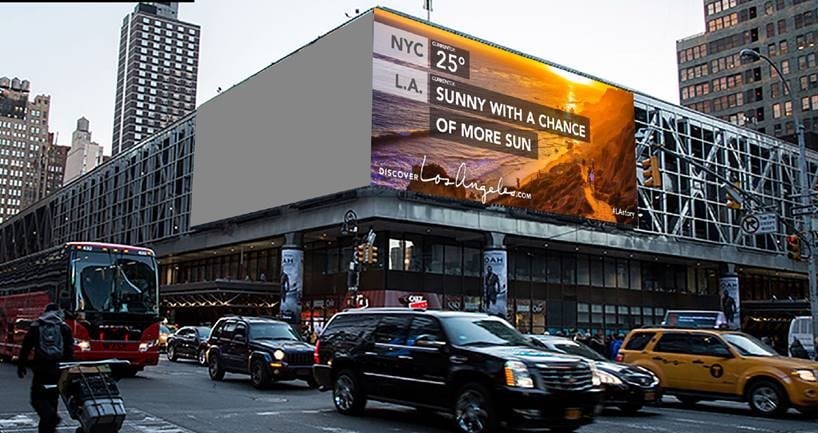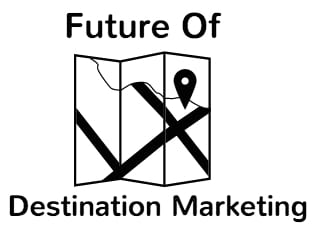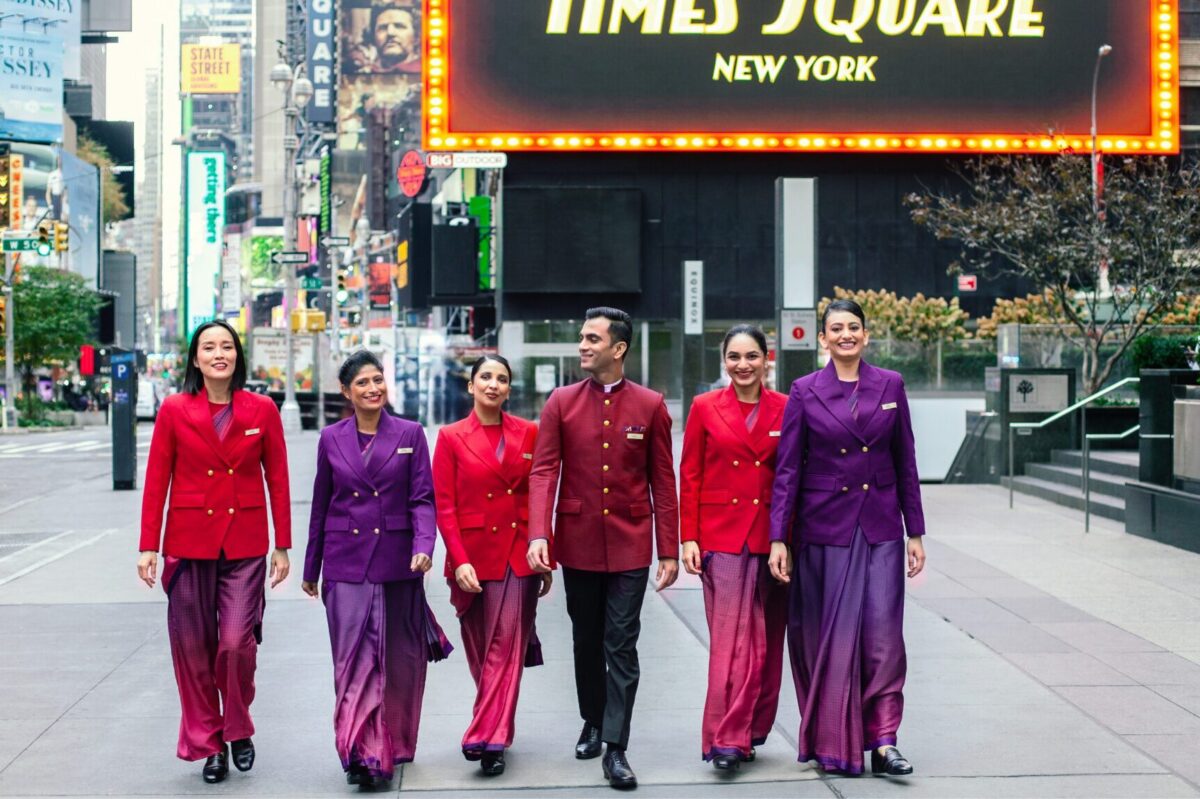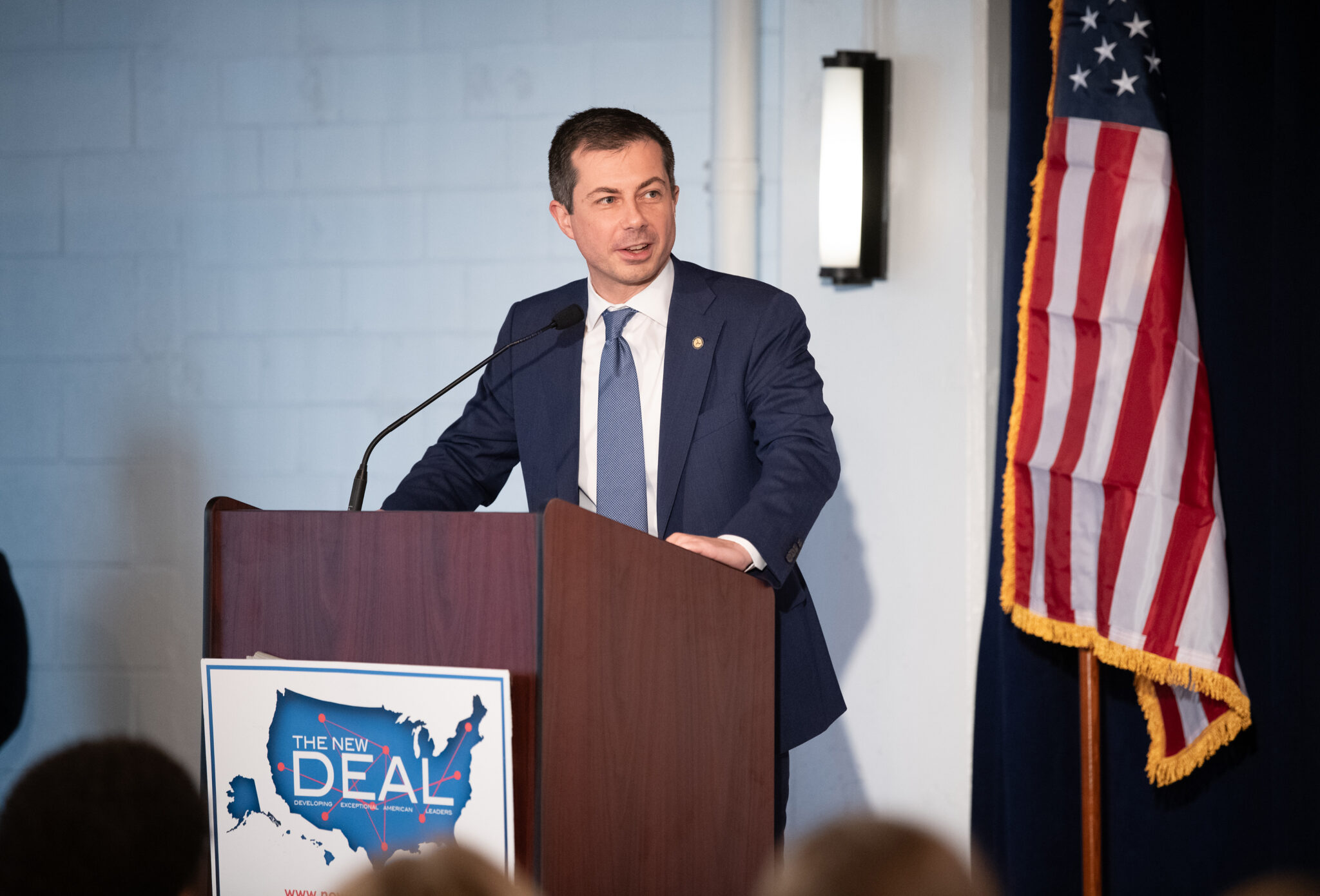Interview: Discover Los Angeles CEO’s Strategies for Success at Home and Abroad

Skift Take
- LA Tourism’s outdoor digital ad compares the temperature in cold-weather cities to the temperature in LA.
- Los Angeles Tourism Board CEO Ernie Wooden Jr.
- “LA Story” is the theme of LA Tourism’s latest campaign push.
- “LA Story” is the theme of LA Tourism’s latest campaign push.
Editor’s Note: Skift is publishing a series of interviews with CEOs of destination marketing organizations where we discuss the future of their organizations and the evolving strategies for attracting visitors. Read all the interviews as they come out here.
This continues our series of CEO interviews that began with online travel CEOs in Future of Travel Booking (now an e-book), and continued with hotel CEOs in the Future of the Guest Experience series (which is also an e-book).
Los Angeles’ recent tourism success is a mix of luck, location, and logic.
As one of the major international gateways to the U.S., the city is benefitting from the growth in global tourism more than most and a combination of its location and cultural ties to China have made it the first stop on most Chinese travelers’ bucket lists.
Los Angeles has also strategically positioned itself to take advantage of these trends by teaching business owners how to work with Chinese customers, building awareness of Los Angeles’ sometimes overlooked neighborhoods and attractions, and fostering partnerships with travel stakeholders on a state and national level.
In one of Skift’s most in-depth tourism interviews yet, we speak with Los Angeles Tourism Board CEO Ernie Wooden Jr. on a broad range of topics including his lessons in attracting Chinese tourists, how to capitalize on tourists’ desires to “live like a local,” and the future of destination marketing organizations.
An edited version of our interview covering everything from Airbnb to Brand USA can be read below:
Skift: Every destination wants more Chinese tourists but Los Angeles has benefited from the growth in outbound Chinese travel more than most. What are some of the lessons that you learned in marketing to Chinese tourists and catering to them once they arrive. What works and what doesn’t work?
Ernest Wooden Jr.: China is the hot subject on everybody’s mind, but it’s been on our minds in Los Angeles for quite a long time. We were one of the first destination marketing organizations to open an office in China in 2006. We had one of the few licenses granted to a city to merchandize directly to the Chinese market. Most organizations work through representatives in China, but we have our own employees in Beijing and Shanghai. We intend to open a third office in Guangzhou within the next six months.
China is a very unique market and we’ve learned some important lessons. For example, we launched a new website that’s based in China to avoid issues. The site that’s based in China looks very different than our DiscoverLA website here in the states. We’ve found that setting up a site in China and managing in out of our offices there works very nicely for us.
We’ve learned the importance of social media in China. We have a very large footprint with about 1.6 million friends on Sino Weibo and a growing following on WeChat. The Chinese market is very engaged in social media so we spend a lot of time thinking about how to engage them.
It helps that we’re Los Angeles, which is bucket list destination in China. Chinese travelers have learned much of what they know about the United States through movies and TV programs so it helps to have that entertainment DNA.
Skift: What’s one mistake you’ve made when it comes to the Chinese market?
Wooden: There are no mistakes that jump out at me, but one thing that’s become clear is the Chinese traveler is young. This is a new endeavor for them. There are nuances that we have to think about when serving the Chinese marketing. For example, Chinese travelers don’t drink cold water with meals and they like having a small napkin next to the bed with slippers so they don’t have to walk on the bare rug. Chinese travelers are not ambitious and inquisitive when it comes to the type of foods that they want to eat. They want good Chinese food whereas as Americans and others are interested in experimenting with foods. We are much more seasoned travelers. We believe that the Chinese travelers will get there, but right now they want good Chinese food. That dictates the kinds of breakfast that we encourage hotels to have when we educate them about how to welcome these travelers.
Skift: What about looking forward? This market is obviously evolving. What are some of the trends you see that destinations have to consider for the future. Are travelers’ habits changing at all? Are a different sector of Chinese citizens traveling?
Wooden: That’s a very good question and the answer to that is,”Yes. Yes, yes and yes.”
There’s a change afoot and it’s particular noticeable when it comes to the “free independent traveler.” These are younger people that are familiar with technology. We used to see one tour guide with a tall flag and 50 people walking behind them. Now younger people are comfortable using apps as guides and traveling alone. You’ll see a second- or third-time visitor to the United States actually rent a car and explore on their own. Many of these travelers are bilingual and comfortable experiencing a destination on their own. That’s not to say that group travel is dead, but this clearly a new trends it ties back to social networking and the way that we merchandize a city through social channels.
Skift: You mentioned the role that movies play in attracting visitors to Los Angeles. As a tourism board, what context can you add to what visitors imagine from the movies?
Wooden: It’s sort of a two-edge sword. Visitors know a lot about America and LA from what they see in the movies but the message isn’t always one that we want to portray. We want to make sure that LA isn’t just seen as the movie capital. There are so many cultural nuances and opportunities. For example, there are 105 museums in the county. People can usually name The Getty but they run out of names after that. We even have more theatre companies than New York. Chinese tour operators often ask us to help them develop itineraries for young travelers because they want to live like an Angeleno. They want to go to clubs, walk down Sunset Strip and go where the movie stars go.
Skift: The desire to live like a local is trend that we’re seeing around the world. What are your thoughts on Airbnb and the opportunities that it provides visitors looking for a more local experience?
Wooden: Airbnb and the sharing economy in general is here to stay, but our hotels are across the city in all of our neighborhoods. We just finished an ambitious initiatives in which we produced 37 neighborhood videos from Chinatown to Hollywood. Each distinct neighborhood has its own story to tell. People have no idea that all of this exists in Los Angeles.
Skift: Many travelers use Airbnb for the experience as much as the location. What are your thoughts on the opportunities that Airbnb creates?
Wooden: It puts visitors in the dead center of some of these neighborhoods and provides an opportunity for people to get a close look at what’s going on there. My outlook is that Airbnb is going to work alongside the traditional hotel community in providing these experiences for people and that will result in higher visitation. All of these choices are a good thing and they’re here to stay.
We don’t promote Airbnb at this point. Los Angeles, like many cities, is grappling with how these business models work with current commercial administrative codes. Our overarching goal is that people that use these secondary booking channels are safe and secure. We are working on a process to make sure that safety and security is protected, that these places are clean and safe. The city wants to have some control over what that experience is going to look like at the end of the day.
Skift: Do you collaborate with Visit California or other cities like San Francisco or San Diego? If so, how closely?
Wooden: We work with Visit California very closely, particularly when we go abroad. We’ll co-op programs together and our marketing people are constantly interacting on new opportunities. Right now we’re working with Visit California and Brand USA on a large Chinese trade event that will be hosted in LA.
We don’t collaborate with other cities in terms of merchandizing ourselves, but we do work together on other projects. For example, if a convention is displaced because a building becomes unavailable then we’ll work closely with our sister cities to make sure the event stays in California. We also work with our cities within Los Angeles, small destination marketing organizations that hitchhike with the bigger DMO. Whether we’re in China, Japan or Australia, we work together as the city of Los Angeles. When it comes to conventions or legislative issues that affect tourism, we are arm-in-arm as a tourism community.
Skift: How do you work with Brand USA to encourage tourism to the U.S.? How can that dynamic be improved?
Wooden: Brand USA has been a Godsend. As one of the major gateways, we work very closely with their marketing team on an international basis. Every time we do an ad or initiative whether in Europe or Australia, Brand USA is right there with us step-by-step. They often co-op advertising costs to a small degree. Brand USA also hosts, at least annually, large familiarization trips for key decision-makers that come from around the world. It’s been a Godsend in terms of raising awareness that the U.S. is rolling out the red carpet to international visitors.
Skift: I’m surprised to hear you sing their praises so highly. They created a video and host some visitors, but it’s not much in comparison to other country tourism boards. What do you think they’re doing that is working so well?
Wooden: They’re doing an awful lot. They’ve targeted about 20 international destinations in their outreach and FAM trips are just 1 percent of what they do. The advertising, outreach and trade education that happens through Brand USA and their DMO partnership is very valuable. For example, Brand USA works alongside our staff whenever they’re in China. Their efforts have brought large MICE groups with thousands of people to California.
It is harnessing all the marketing dollars that they have, in co-op with various destination marketing organizations, to raise awareness of the U.S. I’m a big fan of Brand USA.
Skift: Let’s focus on marketing for a moment. What are the most important platforms that you use for marketing today?
Wooden: There are several and we try to take an integrated approach. The obvious one is our social media platforms, which are such a powerful way of getting the word out about LA and what’s going on here. We have a whole social media team in Beijing, for example, that deals with that part of the world. In terms of integration, the more traditional tools are still there. We have domestic TV ad campaigns across major markets in the United States and Internet campaigns in certain markets where we can’t afford TV ads. Print media is another important platform and we’ve spent a great deal of time trying to grow our earned media. We’ll enjoy more than $50 million in earned media globally this year and that comes as a result of familiarization tours.
We also have a robust digital outdoor initiative that we employ in destinations where it gets cold. We show the temperature of that particular city and then shows the temperature in LA. It’s a mixture of traditional and new generation marketing tools.
Skift: We saw that monthly traffic to DiscoverLA’s website doubled from 310,000 visits in November 2013 to 680,000 in February 2015. What drove that jump?
Wooden: Our complete focus is on the website and we’re putting a lot of money into it. The content is incredibly reliable. Our annual website traffic went from 3 million three years ago to more than 10 million visitors this year.
Our research tells us that more people stay with friends and relatives than stay in our hotels. It’s become clear that our number one concierge is not the hotel concierge but families that are hosting visitors in their homes. They need to figure out what to do with their sister and her three kids on a Saturday. This led us to focus on our website content so that locals have a reliable place to turn to, to build itineraries, and to see what’s happening in the various neighborhoods.
Skift: How do you see DMOs’ position in the travel industry changing in the next five to 10 years? Will they be working more or less closely with other sectors and in-market stakeholders?
Wooden: There’s one significant change that I see happening around DMOs. Our job used to be to hand out brochures at visitor information centers, but today DMOs are seen as a group that promotes the relationship between tourism and economic development.
The organizations are really being challenged by the city and their funding sources who are saying, “We’re glad to see tourists come, but what does that mean? What are you doing to help us fuel job growth and economic development?”
You’ll find that more and more DMOs, starting with myself, are always figuring out what tourism means for the economic growth and stability of the city. For example, we know that 43.4 million tourists came to LA last year, which supported 446,400 jobs in hotels, restaurants, taxis, and attractions. For every 250 new tourists that come to the city, a new job is created somewhere in the tourism tapestry.
More and more DMOs will shout about the relationship between the work that they do and the economy they serve from the highest rooftops. There are going to be major changes in the work flow and their focus on how they do things. In our case, we know that our most valuable tourists are international tourists. They stay long and spend significantly more money than domestic tourists. Since our goal is economic activity and growth, this information shifts our focus to think hard and long about our international efforts. Our research department tries to understand what everyone spends and that’s how we determine how to use our limited funds. Our ultimate goal is to connect tourism with economic activity. More and more DMOs around the country are focusing their activities in such a way to bring economic stability to the cities that they serve.
Skift: How do you think that will impact funding?
Wooden: As we grow tourism in LA, demand for hotel rooms grows. If demand outpaces supply then room rates go up. That’s critical for us because our funding is a percentage of room rate. If RevPar, a measure of occupancy and rates, goes up 10 percent then the money that comes to us increased by 10 percent. As we grow demand, rates increase and our budget benefits. It’s a virtuous cycle.
Skift: If you had 10x more funding, what would you do with it?
Wooden: I have such a long list of wishes. I would accelerate infrastructure issues that I think we struggle to find the right funding for, I’d make it easier for people to see the Hollywood sign and to enjoy Venice Beach. I would also expand our footprint in terms of marketing tools. I am able to spend money on a limited basis in maybe 8 cities, but I’d like that to be national. I would be advertising in markets where I can’t afford to advertise.
Most of the work we do here at the tourism board, about 95 percent, is around the business of bringing people who are outside LA into LA. There’s a real market that we’re missing, which is the 18 million people that live around the city of LA. There’s a real market to grow short-stay vacations from people that live in the valley or Orange County. If I had more money, I’d be able to exploit the culture of tourism in my own backyard. We have wonderful museums and gems around LA that most Angelenos don’t even know about.









